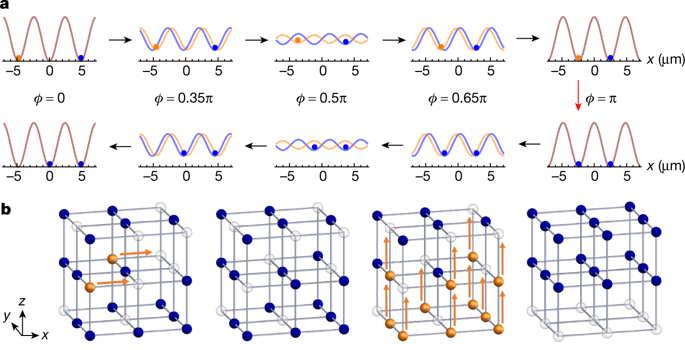Our official English website, www.x-mol.net, welcomes your feedback! (Note: you will need to create a separate account there.)
Sorting ultracold atoms in a three-dimensional optical lattice in a realization of Maxwell’s demon
Nature ( IF 64.8 ) Pub Date : 2018-09-01 , DOI: 10.1038/s41586-018-0458-7 Aishwarya Kumar , Tsung-Yao Wu , Felipe Giraldo , David S. Weiss
Nature ( IF 64.8 ) Pub Date : 2018-09-01 , DOI: 10.1038/s41586-018-0458-7 Aishwarya Kumar , Tsung-Yao Wu , Felipe Giraldo , David S. Weiss

|
In 1872, Maxwell proposed his famous ‘demon’ thought experiment1. By discerning which particles in a gas are hot and which are cold, and then performing a series of reversible actions, Maxwell’s demon could rearrange the particles into a manifestly lower-entropy state. This apparent violation of the second law of thermodynamics was resolved by twentieth-century theoretical work2: the entropy of the Universe is often increased while gathering information3, and there is an unavoidable entropy increase associated with the demon’s memory4. The appeal of the thought experiment has led many real experiments to be framed as demon-like. However, past experiments had no intermediate information storage5, yielded only a small change in the system entropy6,7 or involved systems of four or fewer particles8–10. Here we present an experiment that captures the full essence of Maxwell’s thought experiment. We start with a randomly half-filled three-dimensional optical lattice with about 60 atoms. We make the atoms sufficiently vibrationally cold so that the initial disorder is the dominant entropy. After determining where the atoms are, we execute a series of reversible operations to create a fully filled sublattice, which is a manifestly low-entropy state. Our sorting process lowers the total entropy of the system by a factor of 2.44. This highly filled ultracold array could be used as the starting point for a neutral-atom quantum computer.An experiment inspired by Maxwell’s ‘demon’ thought experiment uses a series of reversible operations to fully fill a three-dimensional optical lattice with ultracold atoms and realize a low-entropy state.
中文翻译:

在麦克斯韦妖的实现中对三维光学晶格中的超冷原子进行排序
1872 年,麦克斯韦提出了他著名的“恶魔”思想实验1。通过辨别气体中哪些粒子是热的,哪些是冷的,然后执行一系列可逆的动作,麦克斯韦妖可以将粒子重新排列成明显的低熵状态。20 世纪的理论工作解决了这种明显违反热力学第二定律的问题:宇宙的熵在收集信息时经常增加 3,并且存在与恶魔的记忆相关的不可避免的熵增加 4。思想实验的吸引力导致许多真实的实验被诬陷为恶魔般的。然而,过去的实验没有中间信息存储 5,仅在系统熵 6、7 中产生很小的变化,或者涉及四个或更少粒子的系统 8-10。在这里,我们展示了一个实验,它捕捉了麦克斯韦思想实验的全部精髓。我们从具有大约 60 个原子的随机半填充三维光学晶格开始。我们使原子振动足够冷,因此初始无序是主要熵。在确定原子的位置后,我们执行一系列可逆操作来创建一个完全填充的亚晶格,这是一个明显的低熵状态。我们的排序过程将系统的总熵降低了 2.44 倍。这种高度填充的超冷阵列可以作为中性原子量子计算机的起点。受麦克斯韦“恶魔”思想实验启发的实验使用一系列可逆操作用超冷原子完全填充三维光学晶格并实现低熵状态。
更新日期:2018-09-01
中文翻译:

在麦克斯韦妖的实现中对三维光学晶格中的超冷原子进行排序
1872 年,麦克斯韦提出了他著名的“恶魔”思想实验1。通过辨别气体中哪些粒子是热的,哪些是冷的,然后执行一系列可逆的动作,麦克斯韦妖可以将粒子重新排列成明显的低熵状态。20 世纪的理论工作解决了这种明显违反热力学第二定律的问题:宇宙的熵在收集信息时经常增加 3,并且存在与恶魔的记忆相关的不可避免的熵增加 4。思想实验的吸引力导致许多真实的实验被诬陷为恶魔般的。然而,过去的实验没有中间信息存储 5,仅在系统熵 6、7 中产生很小的变化,或者涉及四个或更少粒子的系统 8-10。在这里,我们展示了一个实验,它捕捉了麦克斯韦思想实验的全部精髓。我们从具有大约 60 个原子的随机半填充三维光学晶格开始。我们使原子振动足够冷,因此初始无序是主要熵。在确定原子的位置后,我们执行一系列可逆操作来创建一个完全填充的亚晶格,这是一个明显的低熵状态。我们的排序过程将系统的总熵降低了 2.44 倍。这种高度填充的超冷阵列可以作为中性原子量子计算机的起点。受麦克斯韦“恶魔”思想实验启发的实验使用一系列可逆操作用超冷原子完全填充三维光学晶格并实现低熵状态。



























 京公网安备 11010802027423号
京公网安备 11010802027423号